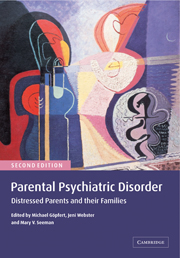Book contents
- Frontmatter
- Contents
- List of contributors
- Foreword
- Preface
- Part I Basic issues
- Part II Comprehensive assessment and treatment
- Part III Specific disorders: the impact on parent–child relationships
- Part IV Specific treatments and service needs
- Part V Child-sensitive therapeutic interventions
- Part VI Models for collaborative services and staff training
- 23 Keeping the family in mind: setting a local agenda for change
- 24 Are services for families with a mentally ill parent adequate?
- 25 Models of service provision in three countries: Marlboro, New Haven, Sydney, Melbourne and Lewisham
- 26 Overcoming obstacles to interagency support: learning from Europe
- 27 Training and practice protocols
- Afterword
- Index
- References
27 - Training and practice protocols
from Part VI - Models for collaborative services and staff training
Published online by Cambridge University Press: 09 August 2009
- Frontmatter
- Contents
- List of contributors
- Foreword
- Preface
- Part I Basic issues
- Part II Comprehensive assessment and treatment
- Part III Specific disorders: the impact on parent–child relationships
- Part IV Specific treatments and service needs
- Part V Child-sensitive therapeutic interventions
- Part VI Models for collaborative services and staff training
- 23 Keeping the family in mind: setting a local agenda for change
- 24 Are services for families with a mentally ill parent adequate?
- 25 Models of service provision in three countries: Marlboro, New Haven, Sydney, Melbourne and Lewisham
- 26 Overcoming obstacles to interagency support: learning from Europe
- 27 Training and practice protocols
- Afterword
- Index
- References
Summary
Introduction
At any point in time one adult in six suffers from a form of mental illness (Department of Health, 1999). The majority of these individuals will live in families and many will have responsibility for looking after children. In turn, those children whose parents experience mental ill-health are at particular risk for a wide range of difficulties in adjustment throughout childhood and adolescence (Cleaver et al., 1999; Downey & Coyne, 1990; Laucht et al., 1994; Rutter, 1966; Watt et al., 1984) (see Hall, Chapter 3). The nature and quality of experiences in earlier years is known to be an important predictor of adult susceptibility to mental ill-health, relationship difficulties and life-long underachievement (Andrews et al., 1990; Bifulco & Moran, 1998; Harris et al., 1987; Landerman et al., 1991; Oliver, 1985; Quinton et al., 1990).
This is a substantial public health issue for all mental health, social and primary care services implicating earlier intervention, mental health promotion and more effective cross-service and interagency collaboration (Meltzer et al., 1995, 2000; Oates, 1997). Yet, despite the increasing awareness of need, there are very few mental health and social care services explicitly configured to address the needs of both mentally ill parents and their children (Reder et al., 2000).
This chapter will describe the development of a training programme commissioned by the Department of Health (UK) in 1998. This is followed by examples of its use and ongoing challenges to implementation and evaluation.
Keywords
- Type
- Chapter
- Information
- Parental Psychiatric DisorderDistressed Parents and their Families, pp. 375 - 392Publisher: Cambridge University PressPrint publication year: 2004



